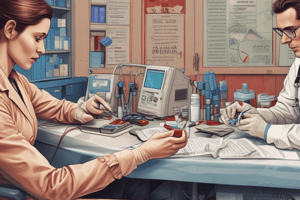Podcast
Questions and Answers
Why is it crucial to follow the specific order of draw when collecting multiple blood samples?
Why is it crucial to follow the specific order of draw when collecting multiple blood samples?
- To prevent cross-contamination of samples (correct)
- To ensure the medical team is aware of the patient's diagnosis
- To prioritize the most critical tests in case of an emergency
- To speed up the blood collection process
What is the main reason for following a specific order of draw when collecting multiple blood samples?
What is the main reason for following a specific order of draw when collecting multiple blood samples?
- To ensure the correct diagnosis of the patient's condition
- To follow the standard operating procedure in the laboratory
- To prevent contamination of the samples with additives from previous tubes (correct)
- To minimize the risk of hemolysis
What is the consequence of not following the specific order of draw when collecting multiple blood samples?
What is the consequence of not following the specific order of draw when collecting multiple blood samples?
- The phlebotomist may be liable for any errors
- The patient may require additional testing
- The test results may be inaccurate or unreliable (correct)
- The samples may be rejected by the laboratory
What is the primary goal of following the specific order of draw when collecting multiple blood samples?
What is the primary goal of following the specific order of draw when collecting multiple blood samples?
Why is it important to follow the recommended order of draw when collecting multiple blood samples?
Why is it important to follow the recommended order of draw when collecting multiple blood samples?
What should be reviewed to account for factors that might affect blood clotting during venipuncture?
What should be reviewed to account for factors that might affect blood clotting during venipuncture?
At what angle should the needle be inserted into the vein during venipuncture?
At what angle should the needle be inserted into the vein during venipuncture?
What should be done immediately after removing the needle to prevent bleeding?
What should be done immediately after removing the needle to prevent bleeding?
Which vein is commonly chosen for venipuncture?
Which vein is commonly chosen for venipuncture?
What is a potential complication of venipuncture involving bleeding under the skin?
What is a potential complication of venipuncture involving bleeding under the skin?
What is the first step in the venipuncture procedure?
What is the first step in the venipuncture procedure?
Study Notes
Blood Sample Collection
- The specific order of draw is crucial when collecting multiple blood samples to avoid cross-contamination of additives between tubes and ensure accurate test results.
- The order of draw helps prevent carryover of additives from one tube to another, which can affect test outcomes.
- Correct ordering also ensures that the blood samples are not compromised, maintaining the integrity of the testing process.
Preparation for Venipuncture
- Verify patient's identification and test request
- Review medical history for bleeding disorders or medications affecting blood clotting
- Wash hands thoroughly and wear gloves
- Choose a suitable vein for venipuncture (median cubital or cephalic vein)
Venipuncture Equipment
- Needles (21-23 gauge)
- Syringes or vacuum tubes
- Tourniquet
- Gauze
- Antiseptic wipe
- Bandage or cotton ball
Venipuncture Procedure
- Restrict blood flow with a tourniquet 3-4 inches above the venipuncture site
- Clean the skin with an antiseptic wipe
- Insert needle at a 15-30° angle, bevel up, into the vein
- Collect blood slowly by pulling back the plunger or using a vacuum tube
- Remove the needle and apply gentle pressure to the site with a gauze or cotton ball
- Release the tourniquet after the needle is removed
- Label the sample with the patient's identification and test request
Post-Procedure Care
- Apply a bandage to the site
- Monitor the patient for bleeding, discomfort, or other complications
- Dispose of used needles and equipment properly
Venipuncture Complications
- Hematoma (bleeding under the skin)
- Nerve damage
- Infection
- Fainting (vasovagal response)
- Allergic reactions to equipment or cleaning agents
Studying That Suits You
Use AI to generate personalized quizzes and flashcards to suit your learning preferences.
Description
Learn why following a specific order of draw is crucial when collecting multiple blood samples. Understand the importance of this process in phlebotomy. Get ready to test your knowledge!





